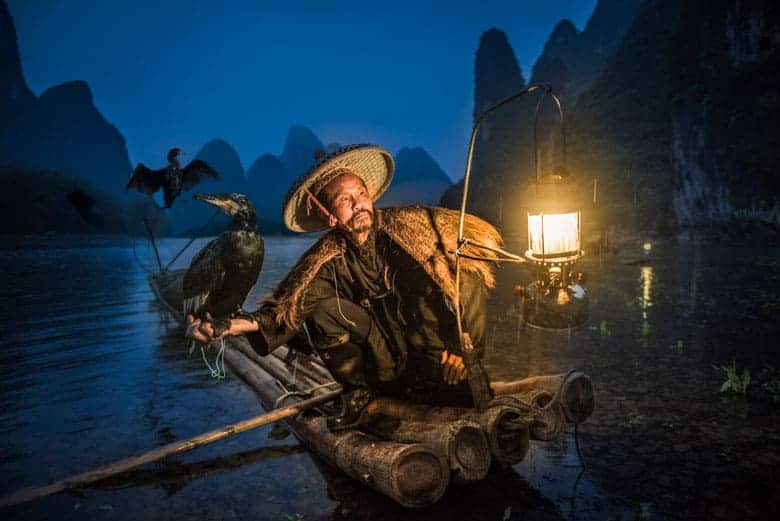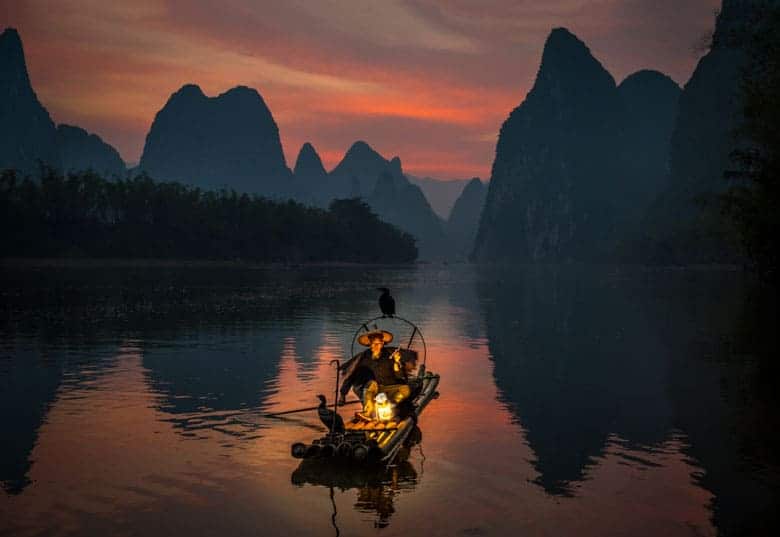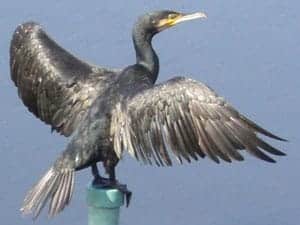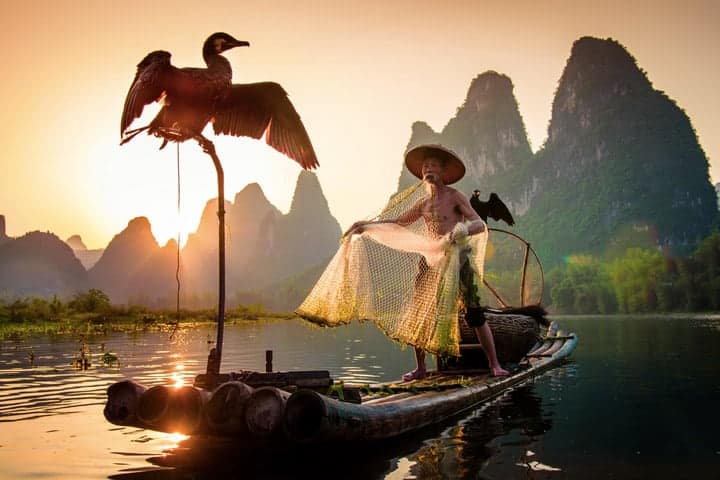
First of all, can I say that I love Petapixel and 500px? I'm a frequent reader of both blogs and we very often site their articles as sources as we discuss news topics on the Improve Photography Podcast. However, I strongly disagree with some of the points made by DL Cade in his article “The Dark Side of Photography: When getting the ‘best' shot is just plain wrong” which was published both on Petapixel and the 500px blog.
I doubt any photographer disagrees with the premise of the article: don't do anything in photography that would destroy the habitat that we photograph. That isn't controversial, and I agree with many of the points in the article.
However, some of the examples are sensationalistic and… well… “just plain wrong.” (See what I did there?) Principally, the example of photographers who travel to China to photograph the cormorant fishermen.
I feel the need to respond clearly to the article, because the author said that those who photograph the cormorant fishermen should “lose the respect of their peers.” I'm one of those photographers.
Unlike the author of the article, I've actually spent time on the Li River in Xingping and have met and photographed several of the cormorant fishermen. I even went to one of their homes. I used the best guides in the business who helped me to get unrivaled access to the area, and I'm leading a workshop to photograph the cormorant fishermen in June 2016.
Much of the information from this article comes from my friends and guides, Andy and Mia Beales, who live in Guilin and probably know the traditional cormorant fishermen better than anyone else in the photography world (they also happen to be the best photo guides in the business). They were able to give me the real facts about this situation–much of it directly from the mouths of the cormorant fishermen themselves.

The Article's Incorrect Accusation
The article says that one of the ways the cormorant fishermen get the cormorant birds to open their wings is to get the bird wet by putting it in the water or splashing a little water on the bird. When the bird has wet wings, it naturally opens them up so they will dry. Some photographers like the way the birds look with their wings spread, so the fishermen periodically do this for the photographers.
Cade's article says the fishermen are committing cruelty to animals, and that any photographer who photographs the fishermen this way should “lose the respect of their peers.” I'm amazed that Mr. Cade would launch a personal attack against the life work of elderly traditional fishermen half way across the world who he hasn't even met and whose culture he does not understand. Though, in his defense, he's really just trusting what photographer Jimmy McIntyre reported from his visit to Guilin.
Fishermen Hold the Birds By the Neck to Protect Them
The real reason the fishermen hold the birds by the neck is because this is the safest way for the animal to be held. The same is true of many animals, such as how a dog holds its puppies by biting the back of its neck. This is especially important for the cormorant, whose wings could easily be broken if not handled properly.

Cormorants are birds which are specially suited to getting wet. In nature they frequently get in the water to gather fish and then return to a log or the ground to spread their wings and dry. This is not an unnatural occurrence.
If getting wet caused great discomfort to the animal as the article suggested, why is it that–in the wild–cormorant birds dunk their own heads underwater multiple times per day and then dry off by spreading their wings?
The birds need to get wet. On very hot, humid days, the black cormorants dehydrate. They open their wings for air to get to the body. In fact, the fishermen sometimes splash water on or dunk their cormorants even when no photography shoot is happening so that the bird can hydrate and stay cool.
A cormorant costs a month's wages in this area of China. The fishermen respect their cormorants and would never dream of hurting them.
For the few men who come from the families that have fished with cormorant birds for so long, their birds are not merely work animals, but prized working pets who they take great care to protect.
We've established two things: holding a cormorant by the neck is actually the gentlest way to hold the animal, and it's very natural and normal for these birds to get wet and dry their wings.

Photography Did Not Destroy Traditional Cormorant Fishing
There are two types of cormorant fishermen in the Guilin area of China: (1) models who pretend to be cormorant fishermen, and (2) the last 5 remaining cormorant fishermen whose families have fished for generations. Most of the photos you see are of men simply posing as the traditional cormorant fishermen. But the traditional cormorant fishermen are also there. They no longer fish commercially (discussed below), but share their heritage with photographers and tourists who come to see their ancient way of life.
The reason the cormorant fishermen no longer fish commercially with their birds is simply that the yield of fish is too low. The cormorant fishermen believe that this is because of the massive influx of illegal fishing by Chinese men who electrocute the water and collect the dead fish. But pollution on the Li river is so severe that I wouldn't doubt it to be a cause as well. These factors slowly eroded away at the generations-old practice of cormorant fishing.
About at the same time, after several of the last few remaining traditional cormorant fishermen stopped fishing, the modeling for photos started. Now, the few remaining TRADITIONAL cormorant fishermen are getting very old, and in at least one case they have no sons to carry on the rich tradition of cormorant fishing.
I want you to read a short portion of what Mia and Andy had to say about photographing the cormorant fishermen, keeping in mind that they know more about this than anyone else on planet earth and spend a great deal of time with the fishermen.
[x_blockquote cite=”Mia and Andy Beales” type=”left”]You are meeting five lovely authentic fishermen–fishermen who are often in their 80's–men who will soon no longer be on the Li River. They are men willing to share their unique tradition. Men who have fished longer then they have been models. Men proud to be Guilin's last authentic fishermen. Men proud to [be] featured in Canon or Nikon [advertisements]. Men who are enjoying earning a little in retirement. Men [whose] houses I can take you to, humble modest old houses with no creature comforts…. It's a beautiful and iconic shot, a staged shot, but a beautiful experience by real fishermen, real people, in their real fishing waters. People who otherwise would be labouring in the village or living off their children's wages, earned in the iPhone factories of Guangdong.[/x_blockquote]
Conclusion
The problem with the “Dark Side of Photography” article's assertion of animal cruelty is that the author simply does not understand the customs of the elderly traditional cormorant fishermen, anything about the cormorant bird itself, nor the way the cormorant fishermen have cared for these working birds for generations.
He simply read something that someone else wrote about a culture that he didn't understand, and called it “abuse.”
To be clear, I don't have any personal animosity against the author. I've never met him but I'm sure he's a great person. But I couldn't see the names of the great cormorant fishermen tarnished without clarification.

Perfect criticism of the original.
In photography, there is a story behind the image. It’s interpreted once by the photographer in how he or she makes the shot. It’s interpreted again by the viewer, based on his or her life experiences, beliefs, and tastes. The viewer can’t know what the whoe story of a photo is, as this dialogue so aptly illustrates. In some ways, that ambiguity is what makes the photographic art interesting. In other ways, it can lead to misunderstandings like this.
Great article. It’s sound to me in few short years there may not even be an opportunity to photograph this fishing culture. So the critics should not try to down grade this form of photography and let everyone enjoy the images and way of living as long as possible.
I’m an avid amateur photographer who also likes to bass fish. The cormorant is the bane of bass fishing because it eats bass (I catch and release). Cormorants are present in Connecticut; they hang out at one of my favorite lakes I photograph. You know that are fishing when you see them dive UNDER the water and stay there for a considerably long time. They come up again for air and a few minutes later they are under water again. It is the way they fish; if the cormorant fisherman of the Li River stick their birds under water, they are only doing what the bird do by nature! I wouldn’t call it animal cruelty.
And, like Jim states in the article, the birds go to logs and branches sticking out of the water and dry their wings by spreading them; again, it’s something the birds do by nature. This is the first time I’ve seen the article in question; I have never engaged in any of the practices he deplores — that’s not entirely true because I have removed a leaf or two over the course of years to give me the photo I want. I’ve never chopped down a tree or sawed off a branch (it’s just too much work!)
The fact that Blackbeard is retired (as are the other four fisherman) does not detract from the ability of the photographer to capture a good image. That would be like saying that you can’t go to a zoo to photograph the lions in their “natural” habitat and then use that photo in a blog or sell it for advertising purposes.
There is no shortage of Westerner’s ready to judge the culture customs and traditions of others.
For lack of better words : Spot On !!
DL Cades, in all due respect, if you never knew personally about the life of the cormorrant fishermen, don’t pretend like you know more about those fishermen, nor judging them on what they did good or bad. I have seen them personally, met them personally and met their familes as well. Their lives are so different from what you have described in your article.
Excellent, well structured response. It’s nice to hear straight from the “horse’s mouth” in the statement from the Beales. Maybe DL Cade should go visit Guilin himself. (Heaven knows, I’d like to!)
I was lucky enough to join Jim on his trip this year to Guilin. I agree totally with Jim and Andy’s view. The three different fisherman that we worked with were never aggressive or rough with the birds and were proud to demonstrate a tradition that is disappearing from the Li River. It was an honor to photograph these men and seeing the craft that they had practiced their whole life. I feel fortunate to have had the chance and would encourage any photographer that wants a once-in-a-lifetime experience to visit the area and use Andy and Mia as your guides as they are not only very knowledgable on the area, but also the people and their culture.
Too often, people glance at a standard animal husbandry practice and make huge assumptions without stopping to think and give it a fair analysis. Just because something would be painful and damaging to a human does not make it so for the animal, and vice versa. Same applies to many, many practices of livestock handling that draw ire from people that have never been on a farm. No one does these things because they want to hurt the animals- that would make no economic sense.
Thanks for the critique and explaining more about the culture, very interesting!
I know I’m a bit late to the party, but I just recently discovered your post. You have some good and valid points here, and I really appreciate that you focus on the dwindling practice of cormorant fishing and the last remaining fishermen, in contrast to the models most people are shooting.
But I feel that I have to correct you on one point. In your article you state:
“The real reason the fishermen hold the birds by the neck is because this is the safest way for the animal to be held. The same is true of many animals, such as how a dog holds its puppies by biting the back of its neck. This is especially important for the cormorant, whose wings could easily be broken if not handled properly.”
What you say here is not correct, I’m afraid. I’m a licensed bird ringer and I’ve been through training on how to handle live birds, and grabbing birds by the neck is **not** encouraged (to say it politely). What bird ringers learn are summed up in the best practice recommendations in chapter 4 of UNs FAO publication [Wild Bird and Avian influenza](ftp://ftp.fao.org/docrep/fao/010/a1521e/a1521e04.pdf) on how to handle wild birds, and here you will not find any recommendations on grabbing birds by the neck. As an important general rule this document states:
“Safe handling is achieved by controlling the bird’s head, feet, legs and wings; however,you should never move these appendages into awkward or unnatural positions that may injure the bird.”
Grabbing a bird by the neck is an akward an unnatural position that may injure the bird. Dogs and cats are completely different species, and their way of carrying puppies have been evolved through hundreds of thousands of years. To my knowledge you will not find any bird species doing the same thing with their youngs. And because of that they doesn’t have the same kind of loose and soft skin on their neck that puppies and kittens have.
I know there’s a lot of domestic birds beeing handled by grabbing the neck, but that doesn’t make it any better: it’s just not a recommendable way of handling birds, wild or tame.
One can also question if it’s a good practice to collect wild cormorant chicks from their nests to be trained for this type of fishing, but I’ll leave that for others to do.
I think that we as photographers should let this ancient (and well documented) practice die out peacefully and in grace, and not help sustaining perverted imitations of it just for the sake of getting our own images.
Beautifully articulated … Critiqued, yet didn’t “lash-out” & ridicule the author.
Most importantly you substantiated your reasons with a solid article validating your reasons & their way of life.
Kudos !!